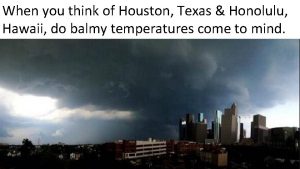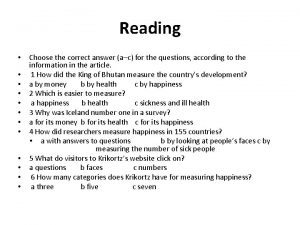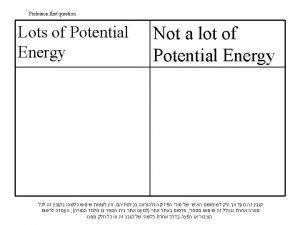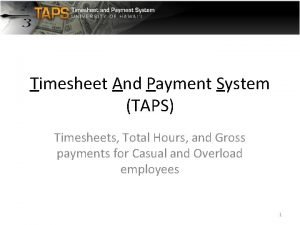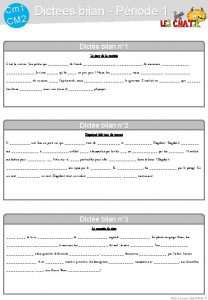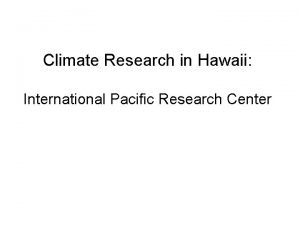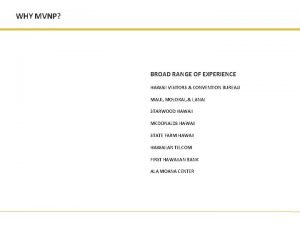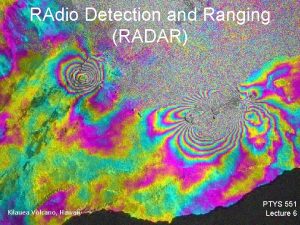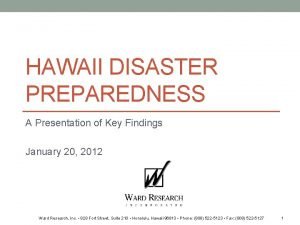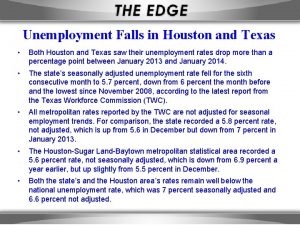When you think of Houston Texas Honolulu Hawaii




















































































- Slides: 84

When you think of Houston, Texas & Honolulu, Hawaii, do balmy temperatures come to mind.

When you think of Houston, Texas & Honolulu, Hawaii, do balmy temperatures come to mind. ? Both cities have a mean temperature of 750.

However, the mean temperature does not tell the whole story.

The temperature in Houston differs seasonally 0 from a low of about 40 in January to a high of close to 1000 in July and August.

By contrast, Honolulu’s temperature varies less throughout the year, usually ranging between 600 and 900.

Measures of dispersion are used to describe the spread of data items in a data set.

Measures of dispersion are used to describe the spread of data items in a data set. Two of the most common measures of dispersion,

Measures of dispersion are used to describe the spread of data items in a data set. Two of the most common measures of dispersion, the range

Measures of dispersion are used to describe the spread of data items in a data set. Two of the most common measures of dispersion, the range and the standard deviation, are discussed in this section.

The Range A quick but rough measure of dispersion is the range,

The Range A quick but rough measure of dispersion is the range, the difference between the highest

The Range A quick but rough measure of dispersion is the range, the difference between the highest and lowest data values in a data set.

For example Houston’s hottest annual 0 temperature is 103

For example Houston’s hottest annual 0 temperature is 103 and its coldest annual temperature is 330.

For example Houston’s hottest annual 0 temperature is 103 and its coldest annual temperature is 330. The range in temperature is

For example Houston’s hottest annual 0 temperature is 103 and its coldest annual temperature is 330. The range in temperature is

For example Houston’s hottest annual 0 temperature is 103 and its coldest annual temperature is 330. The range in temperature is

For example Houston’s hottest annual 0 temperature is 103 and its coldest annual temperature is 330. The range in temperature is

For example Houston’s hottest annual 0 temperature is 103 and its coldest annual temperature is 330. The range in temperature is

For example Houston’s hottest annual 0 temperature is 103 and its coldest annual temperature is 330. The range in temperature is

Honolulu’s hottest day is 0 89

Honolulu’s hottest day is 0 say is 61. 0 89 and its coldest

Honolulu’s hottest day is 0 say is 61. 0 89 The range in temperature is and its coldest

Honolulu’s hottest day is 0 say is 61. 0 89 The range in temperature is and its coldest

Honolulu’s hottest day is 0 say is 61. 0 89 The range in temperature is and its coldest

Honolulu’s hottest day is 0 say is 61. 0 89 The range in temperature is and its coldest

Honolulu’s hottest day is 0 say is 61. 0 89 The range in temperature is and its coldest

Honolulu’s hottest day is 0 say is 61. 0 89 The range in temperature is and its coldest

The Range.

The Range The range, the difference between the highest

The Range The range, the difference between the highest and lowest data values in a data set,

The Range The range, the difference between the highest and lowest data values in a data set, indicates the total spread of the data.

The Range The range, the difference between the highest and lowest data values in a data set, indicates the total spread of the data.

The Range The range, the difference between the highest and lowest data values in a data set, indicates the total spread of the data.

The Range The range, the difference between the highest and lowest data values in a data set, indicates the total spread of the data.

The Range The range, the difference between the highest and lowest data values in a data set, indicates the total spread of the data.

(millions) 472 106 Country 82 Brazil China 147 India U. S. Indonesia Number of Workers 778 The table shows the number of workers, in millions, for the five countries with the largest labor forces.

(millions) 472 106 Country 82 Brazil China 147 India U. S. Indonesia Number of Workers Find the range of workers in millions, for these five countries. 778

(millions) 472 106 Country 82 Brazil China 147 India U. S. Indonesia Number of Workers Find the range of workers in millions, for these five countries. 778

(millions) 472 106 Country 82 Brazil China 147 India U. S. Indonesia Number of Workers Find the range of workers in millions, for these five countries. 778

(millions) 472 106 Country 82 Brazil China 147 India U. S. Indonesia Number of Workers Find the range of workers in millions, for these five countries. 778

(millions) 472 106 Country 82 Brazil China 147 India U. S. Indonesia Number of Workers Find the range of workers in millions, for these five countries. 778

(millions) 472 106 Country 82 Brazil China 147 India U. S. Indonesia Number of Workers Find the range of workers in millions, for these five countries. 778

The Standard Deviation

The Standard Deviation

The Standard Deviation A second measure of dispersion,

The Standard Deviation A second measure of dispersion, and one that is dependent on all of the data items

The Standard Deviation A second measure of dispersion, and one that is dependent on all of the data items is called the standard deviation.

The standard deviation

The standard deviation is found by determining how much each data item differs

The standard deviation is found by determining how much each data item differs from the mean.

In order to compute the standard deviation,

In order to compute the standard deviation, it is necessary to find by how much each data item

In order to compute the standard deviation, it is necessary to find by how much each data item deviates from the mean.

In order to compute the standard deviation, it is necessary to find by how much each data item deviates from the mean. First compute the mean.

In order to compute the standard deviation, it is necessary to find by how much each data item deviates from the mean. First compute the mean.

Then subtract the mean from each data item.

Then subtract the mean from each data item.

Then subtract the mean from each data item.

Then subtract the mean from each data item.

(millions) 472 106 Country 82 Brazil China 147 India U. S. Indonesia Number of Workers 778 Find the deviations from the mean for the five data items.

(millions) 472 106 Country 82 Brazil China 147 India U. S. Indonesia Number of Workers 778 Find the deviations from the mean for the five data items.

(millions) 472 106 Country 82 Brazil China 147 India U. S. Indonesia Number of Workers 778 Find the deviations from the mean for the five data items.

(millions) 472 106 Country 82 Brazil China 147 India U. S. Indonesia Number of Workers 778 Find the deviations from the mean for the five data items.

(millions) 472 106 Country 82 Brazil China 147 India U. S. Indonesia Number of Workers 778 Find the deviations from the mean for the five data items.

(millions) 472 106 Country 82 Brazil China 147 India U. S. Indonesia Number of Workers 778 Find the deviations from the mean for the five data items.

(millions) 472 106 Country 82 Brazil China 147 India U. S. Indonesia Number of Workers 778 Find the deviations from the mean for the five data items.

Find the deviations from the mean for the five data items.

First calculate the mean

First calculate the mean

First calculate the mean

First calculate the mean

First calculate the mean

First calculate the mean

First calculate the mean

First calculate the mean

First calculate the mean

First calculate the mean

First calculate the mean

First calculate the mean

First calculate the mean

First calculate the mean

First calculate the mean

First calculate the mean
 Baton rouge louisiana indianapolis indiana
Baton rouge louisiana indianapolis indiana Houston texas to hawaii
Houston texas to hawaii Think big think fast think ahead
Think big think fast think ahead Houston isd foundation houston, tx
Houston isd foundation houston, tx If you think you can you can poem
If you think you can you can poem Honolulu cookie company whalers village
Honolulu cookie company whalers village Honolulu vpn
Honolulu vpn 700 n san jacinto jail
700 n san jacinto jail Why according to robin and jay are people funny
Why according to robin and jay are people funny Think fam think
Think fam think Did you feel it hawaii
Did you feel it hawaii Have a daughter so you can argue
Have a daughter so you can argue Choose the correct answers a c
Choose the correct answers a c Alan and susie an argument
Alan and susie an argument You know minecraft
You know minecraft Words that come to mind when you think of family
Words that come to mind when you think of family You have more potential than you think
You have more potential than you think What do you think of when you hear the word science
What do you think of when you hear the word science What do you think of when you hear
What do you think of when you hear So you think you can argue
So you think you can argue 5 paragraph essay about hawaii
5 paragraph essay about hawaii Hinalea fish
Hinalea fish Hawaii.edutaps
Hawaii.edutaps How was hawaii formed
How was hawaii formed Necker island hawaii
Necker island hawaii Dr wheatley hawaii
Dr wheatley hawaii Soest hawaii
Soest hawaii Usda zones hawaii
Usda zones hawaii Metamorphic rocks in hawaii
Metamorphic rocks in hawaii Franklin covey hawaii
Franklin covey hawaii Wwwifa hawaii
Wwwifa hawaii Sba testing hawaii
Sba testing hawaii Ashley barr hawaii
Ashley barr hawaii Hawaii academy of arts and sciences
Hawaii academy of arts and sciences I could hear hawaii calling my name
I could hear hawaii calling my name Single slit envelope
Single slit envelope Dictee lava hawaii
Dictee lava hawaii Http //www.phys.hawaii.edu/ teb/optics/java/slitdiffr/
Http //www.phys.hawaii.edu/ teb/optics/java/slitdiffr/ Hawaii early learning profile
Hawaii early learning profile Alaska proper adjective
Alaska proper adjective What is pollution
What is pollution Wwii
Wwii University of hawaii soest
University of hawaii soest The us annexes hawaii
The us annexes hawaii Elder abuse hawaii
Elder abuse hawaii Age of imperialism
Age of imperialism Hawaiian hotspot
Hawaiian hotspot When did hawaii get statehood
When did hawaii get statehood Isla central de hawai entre kauai y molokai
Isla central de hawai entre kauai y molokai Hawaii windward vs leeward
Hawaii windward vs leeward Interesting facts about hawaii
Interesting facts about hawaii Hemic hawaii
Hemic hawaii Tsunami siren hawaii
Tsunami siren hawaii Science standards hawaii
Science standards hawaii Iprc hawaii
Iprc hawaii Mvnp hawaii
Mvnp hawaii British cession 1818
British cession 1818 Veronika pohancanikova
Veronika pohancanikova Crocodile snake iguana
Crocodile snake iguana American electric hawaii
American electric hawaii Hawaii branding agencies
Hawaii branding agencies Hawaii equator
Hawaii equator Proper adjective for hawaii
Proper adjective for hawaii Hedco loans hawaii
Hedco loans hawaii Texture of rocks that have many pits from gas escape.
Texture of rocks that have many pits from gas escape. Hawaii conservation conference
Hawaii conservation conference Hawaii flood hazard assessment tool
Hawaii flood hazard assessment tool Sses hawaii
Sses hawaii Chemstation hawaii
Chemstation hawaii Byran uyesugi now
Byran uyesugi now Mare hawaii
Mare hawaii Lds hawaii doe
Lds hawaii doe Myuhportal.hawaii.edu
Myuhportal.hawaii.edu Hawaii space flight laboratory
Hawaii space flight laboratory History of sugar timeline
History of sugar timeline Hawaii office of planning
Hawaii office of planning Hawaii
Hawaii University of hawaii
University of hawaii I could hear hawaii calling my name
I could hear hawaii calling my name Important agricultural lands hawaii
Important agricultural lands hawaii Usgs.gov
Usgs.gov Hawaii forest institute
Hawaii forest institute Hawaii disaster preparedness
Hawaii disaster preparedness Hawaii child nutrition program
Hawaii child nutrition program Zastava hawaii
Zastava hawaii

